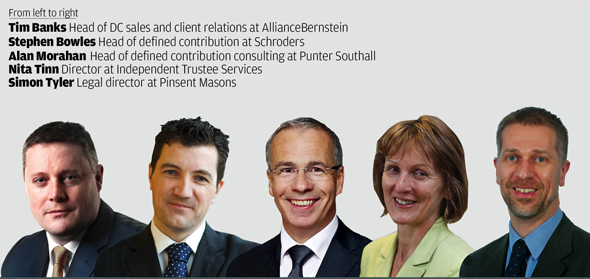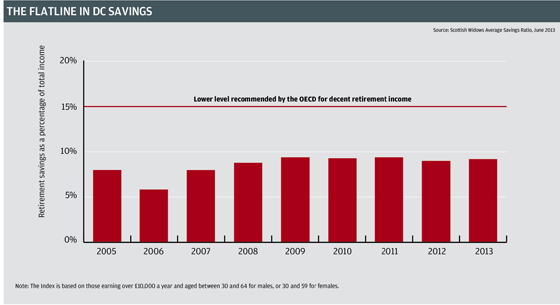This edition of our quarterly feature asks DC experts what is stifling investment innovation, and whether scheme, employer or provider is responsible for achieving good governance.

How will the charges cap on default funds affect DC schemes?
Simon Tyler: The most surprising thing about a charges cap is that the government did not impose one when auto-enrolment first came in, as it did when it introduced stakeholder pensions. If the level is similar to the one for stakeholder, very few auto-enrolment schemes will be affected. But those like the National Employment Savings Trust, which imposes a charge on contributions in addition to an annual management charge, could fall foul of the cap. The government will have to design it around that, or risk upsetting Nest’s long-term business plan.
Nita Tinn: One consequence could be a slowdown in the rate of investment in defined contribution innovation. Already there is a wide gulf between what is available at the cutting edge of DC and what the average member has to choose from. There is growing popularity in diversified growth funds, but many schemes will not have access to them if the cap is set at the Pension Quality Mark level of 75 basis points, because the average charge of an actively managed DGF is around 75bp without the admin element.
Alan Morahan: There is a real danger here. If the total focus is on charges then we know it is possible to construct a fund using passive investments at an annual management charge of 20bp or less. However, this fund could provide investors with an uncomfortable journey. Sharp falls in fund value can often result in savers ceasing contributions or withdrawing funds completely. A fund with greater diversification, tilted towards the right assets while aiming to minimise exposure to downward-trending markets, will cost more to run but could provide a much smoother journey.
Stephen Bowles: The primary impact will be to place even more downward fee pressure on the investment component of the default. This presents a challenge to the investment community and particularly the active investment community. Beta is cheap, alpha is not. But to deliver better member outcomes we need more than just cheap equity beta. The investment management community is beginning to rise to the challenge, but the DC market has historically been slow to adopt innovation. Those who govern these schemes need to become more comfortable with new investment options and tools if they want to deliver better member outcomes.
Tim Banks: Most of the institutional pricing in the market is well under the proposed cap. It is strange that we need a cap at all as UK DC pricing is generally low in global terms, especially given the market size. Even so, the cap does have the potential to stifle market innovation as the market develops. It should be remembered that the charge in the default fund pays for a range of services, of which the fund management fee is only one element. Trustees and managers should demand full disclosure of charges for bundled DC services.
Pension providers are increasingly launching committees to boost oversight, but should governance be dealt with at the employer, scheme or provider level, and why?
Morahan: The Pensions Regulator has issued 31 quality features for work-based pension schemes, which will form a DC code of practice to become law later this year. Many of these are aimed specifically at providers, and a governance committee is a way of complying. But this does not abdicate employers from a responsibility to review schemes and we may move to an era of two levels of governance. As long as this does not add to the cost, it should be a good thing.
Tinn: One criticism levelled at contract-based schemes is the lack of independent review of the provider’s services past the point of sale. While a governance committee cannot fulfill the role of an independent trustee board with fiduciary responsibilities to the members, it can influence the provider’s behaviors. Though a number of larger employers already operate governance committees, the vast majority of group personal pension schemes have nothing in place. The move by some insurers to introduce these committees will go some way towards bridging the gap between contract and trust.
Banks: A well-constructed governance committee can make value judgments on behalf of its members. Those members would expect someone to be on their side, both setting the objectives for, and making judgments about the effectiveness and delivery of the chosen strategy. The implementation of these tasks could be done directly by the employer, scheme or provider, or parts of it could be subcontracted.
Tyler: Unfortunately, employers who opt for a contract-based scheme are often reluctant to do more than the legal minimum. An obvious solution would be to impose a duty on employers to exercise reasonable care in selecting and monitoring their schemes. The government has so far rejected this solution as it doesn’t exactly tie in with its campaign to reduce red tape. Governance committees established by providers are welcome, but untested.
Bowles: The determining factor should be an assessment of who can provide robust, unfettered and well-resourced governance. While a strong argument can be made that trust-based schemes are unfettered, the evidence is not all of these schemes have robust and timely governance. Let us not worry too much about who is doing it but rather [they are] undertaking it in the best interests of the member.
The determining factor should be an assessment of who can provide robust, unfettered and well-resourced governance. While a strong argument can be made that trust-based schemes are unfettered, the evidence is not all of these schemes have robust and timely governance. Let us not worry too much about who is doing it but rather [they are] undertaking it in the best interests of the member.
What do you think will be the future innovations in DC investment, and how might they improve schemes for members?
Bowles: The issue is demand. The market has been dominated by low-fee beta-based solutions, and until it fully embraces the concept of value for money, many of the innovative alternatives will wither on the vine.
We need to remove the requirements for daily dealing in defined contribution
One of the concepts we see gaining significant traction is stable growth, the ability to deliver growth but with much more certainty of outcome. Even in an environment of lower fees, there are tools such as volatility caps which will enable some asset managers to deliver cost-effective but significantly less volatile outcomes
Morahan: Members crave some assurance that they are at least going to get their money back. However, the costs of providing guarantees are prohibitive and can limit the upside return and, in any event, just getting the contributions back does little towards attaining a decent benefit at retirement. We need to be able to demonstrate to members that multi-asset funds and DGFs can deliver a good return over time while limiting the downside risk in difficult market conditions.
Tyler: In the past, innovation has focused on sophisticated investors. Auto-enrolment dramatically boosts the number of modest pension savers. The challenge will be to come up with strategies that suit them. This may mean offering members no investment choice at all, while taking care to adopt a suitably structured investment strategy. Or it may mean opening up income drawdown to more modest pension savers through appropriately targeted funds at retirement. The trick will be to ensure that members understand exactly what is happening with their pots, and what to expect.
Banks: Focusing on innovation in DC is incredibly important and much conventional wisdom is outdated. Having said that, the UK market is slow to adopt new ideas. Perhaps this is unsurprising given that fiduciaries are rightly cautious about change when it comes to pension assets. From a provider’s point of view, it does mean that you have to be very focused on the DC market, and invest heavily upfront to succeed.
Tinn: Prior to innovating we need to remove the requirements for daily dealing in DC, which would open a whole world of alternative investment vehicles to investors. The increasing use of drawdown, as the generation of workers with DC-only pensions approaches retirement, should lead to an increase in the range of products available. Significant growth in the use of DGF funds in DC is likely to continue, with increasing use of derivatives to smooth returns, while focusing on capital preservation and achieving inflation plus growth, all of which should help narrow the range of potential outcomes for members.
How can employers and schemes encourage employees to start saving early, and to go above the statutory or scheme minimum?
Bowles: If encouragement was the solution to this problem we would have cracked it by now. We’ve reached the point in DC where we have to accept that trying to encourage employees to do the right thing is not the most efficient way of changing behaviour. Auto-enrolment is the first step down that path to saving earlier and saving more.
Pension saving needs to be as user-friendly as online banking
We certainly need to educate and inform, but ultimately we need to take the decision away from members, whose short-termism on pensions is only rivalled by that of our politicians.
Morahan: The statutory minima through auto-enrolment will not be enough for a good level of income in retirement and this is recognised by the regulator. Techniques like ‘save more tomorrow’, where members’ contributions are automatically increased by a small amount each year, can be effective and, if linked to pay increase, relatively painless.

Tinn: One major deterrent to younger people saving for retirement is the fact they are locking away their savings for a considerable period with no possibility of early access. To help overcome this, some legislative changes would be needed to enable members to access savings early. Another approach would be to simplify the tax treatment of savings generally to make it easier for people to switch from medium-term savings, such as ISAs, to longer-term pension vehicles.
Banks: I would hope in four years’ time we can look back and agree auto-enrolment has largely solved the issue of member participation. With greater participation will come a better understanding by individuals of likely outcomes from their schemes. This, coupled with the step-up in minimum contributions, will inevitably drive average contribution rates higher.
Tyler: To get a workforce interested in pensions, you have to put in some effort. A successful awareness campaign can help to turn pension schemes back into the retention and recruitment tool they have been in the past. Employers are free to encourage employees to save as long as they steer clear of giving individual financial advice. Pension saving needs to be as user friendly as online banking. Attractive, easy-to-use web tools can help workers to think about what they can realistically aim for, and to budget accordingly.














